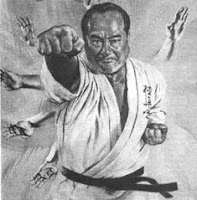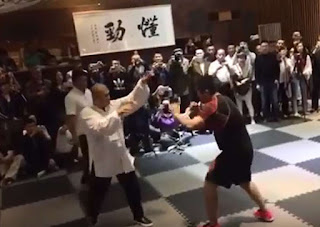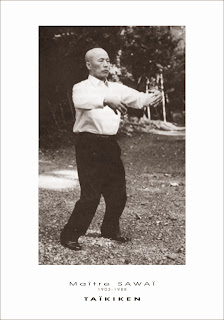Channan vs. pinan/heian
.jpg) |
| Gichin Funakoshi in the 1930s |
The 5 heian kata of shotokan are substantially the same as the "original" series, apart from 2 main differences:
- they were "renamed" from the original "pinan" to "heian"; and
- the order of the first two kata was reversed.
So who created the "original" 5 pinan? Are they based on some traditional Chinese form?
It is commonly agreed that the author of the 5 pinan was karate master Yasutsune "Anko" Itosu (1832-1915) and that they were created in the early 1900s for teaching within the Okinawan school system.
If you look at this series of kata, you see that they contain many of the movements or principles from more "advanced" kata such as kusanku - albeit stripped down to "stem cell movements". In other words, it seems that the 5 pinan were an attempt to create "simpler" more "elemental" kata for teaching younger students in a school setting - and that is all.
By contrast, there are many who would insist on cloaking these 5 basic kata in some sort of "mystique". And there is no better way to create such mystique than by suggesting that these kata are based on an older, "lost" kata: perhaps some Chinese form that held innumerable secrets, many (most?) of which were stripped out in the process of simplification for teaching schoolchildren.
It is in this context that the "lost channan myth" rears its head.
"Lost channan" is like one of those rumours that starts with a half-remembered anecdote, then morphs into a well-known apocryphal tale. Mark Bishop records a number of such tales in his book "Okinawan Karate: Teachers, Styles and Secret Techniques".1 One is that Itosu learned a form called "chiang nan" from a shipwrecked Chinese sailor - a form he then divided up into the 5 pinan. There is really nothing to corroborate such a fantastical story.
 |
| Anko Itosu |
Again, there is nothing to corroborate the existence of any martial arts master from, or known as, "Annan" or "Channan".
So what do we know about the origin of the pinan kata? Precious little. But what little we do know is, I think, consistent with the observation that they were entirely Itosu's invention - not a derivation of any existing form.
One of the few scraps of information we actually have regarding pinan/channan comes from a 1934 karate research journal "Karate no Kenkyu" in which Choki Motobu is quoted as follows:
"I visited him [Itosu] one day at his home near the school, where we sat talking about the martial arts and current affairs. While I was there, 2-3 students also dropped by and sat talking with us. Itosu Sensei turned to the students and said 'show us a kata.' The kata that they performed was very similar to the Channan kata that I knew [from studying with Itosu], but there were some differences also. Upon asking the student what the kata was, he replied 'It is Pinan no Kata.' The students left shortly after that, upon which I turned to Itosu Sensei and said 'I learned a kata called Channan, but the kata that those students just performed now was different. What is going on?' Itosu Sensei replied 'Yes, the kata is slightly different, but the kata that you just saw is the kata that I have decided upon. The students all told me that the name Pinan is better, so I went along with the opinions of the young people.' These kata, which were developed by Itosu Sensei, underwent change even during his own lifetime."3If we are to proceed on the small amount of evidence (however "hearsay" in nature), we must conclude that it points to Itosu inventing the pinans as a series of basic forms for schoolchildren. Perhaps he used kusanku as a base and then "cut down" the pinans - perhaps not; the similarities might simply be that kusanku, like many shorin kata, features certain fundamental techniques. When you are constructing a a series of kata principally so as to teach "stem cell movements" it is inevitable that these fundamental techniques will feature.
The name "channan" appears to be nothing more than an early "working title" for these forms: forms that eventually became known as "pinan". There is no evidence of any kind to suggest that the latter basic kata were based on some older Chinese form taught to Itosu by a "shipwrecked sailor" or anyone else.
.jpg) |
| Funakoshi leading a class in heian kata |
I think we get some clue by looking at the oral tradition almost all shorin karateka have inherited. In my experience, if you ask a shorin karateka what "pinan" or "heian" means there is a good chance they will reply: "Peaceful mind."
Yet "pinan" doesn't exactly mean that.
The characters for pinan are 平安 (in Chinese: "ping2 an1") meaning "safe and sound; well; without mishap". (On their own, "pin/ping" means "flat, level, even; peaceful" while "an" means "peaceful, tranquil, quiet".)
What of "heian"? Didn't Funakoshi "rename" the kata? Not exactly. "Pinan" is just the Okinawan pronunciation of the Chinese characters. In standard Japanese these same characters are pronounced "heian". There is no difference in the name: Funakoshi was merely using standard Japanese when referring to these kata.
So it's clear where "peaceful" comes from - but what about the reference to "mind"? Why does this reference linger in the "cultural memory" of the name of this form?
Clearly the character "an" can refer to being "tranquil" - which is itself a "state of mind". And read together with "pin/hei" one can understand them as a reference to a "peaceful/level state of mind". But I think this reading of the characters also gives us a clue as to the process by which the name came to be chosen - and the likely meaning of Itosu's "working title" of "channan".
I think it is reasonable to conclude that the "an" in "channan" is the same character as in pinan/heian - ie. 安. But what about "chan"? Some have suggested it might be an Okinawan shortening of the Chinese "chang" - ie. 長 meaning "long" (as in changquan 長拳 or "long fist") however I see nothing to support this other than a superficial resemblance between all of shorin karate and longfist gongfu.4
So what other meanings could "chan/chang" might be relevant? Personally, I can think of only one - and that is the Chinese character for meditation or contemplation - 禪 (chan2). In standard Japanese this character is pronounced "zen". The latter automatically gives rise to impressions of Zen Buddhism - but of course, the character has a broader meaning than that - one that is qualified by its context.5
Read together 禪安 (chan2 an1) would mean something like "meditative tranquillity" - or just "peaceful mind"!
Accordingly I think the available evidence, and the principle of Occam's razor, leads us to the rather simple conclusion that channan kata was just a working title for a series of forms that became the 5 pinan kata. These kata were named after a mindset highly esteemed in all Okinawan/Japanese arts - namely a state of relaxed alertness known as 残心 or "zanshin" in Japanese.6
 |
| An artwork of mine of the character "An" titled "Tranquillity" |
The story becomes even more incredible when you consider that this Chinese master purportedly taught to Itosu a form comprising rather basic/fundamental movements - movements that are by and large already found in karate kata.7
Accordingly it seems to me that the notion of a "lost" channan kata comprises a highly unlikely proposition. Channan was never "lost" because it has continued to exist from its inception up to the present day - in the form of the various pinan/heian kata so many of karateka practise right around the world.
Footnotes:
1. Bishop, M. (1999) Okinawan Karate: Teachers, Styles and Secret Techniques, 2nd Edition. Boston: Charles E. Tuttle, Co.
2. I refer you to the excellent article by Joe Swift titled "Channan: the lost kata of Itosu?" in which Joe cites the following historians who suggest the "teacher named Channan" theory:
Gima S. and Fujiwara R. (1986) Taidan: Kindai Karatedo no Rekishi wo Kataru (Talks on the History of Modern Karatedo). Tokyo: Baseball Magazine.
Iwai T. (1992). Koden Ryukyu Karatejutsu (Old-Style Ryukyu Karatejutsu). Tokyo: Airyudo.
Kinjo A. (1999) Karate-den Shinroku (True Record of Karate's Transmission). Naha: Okinawa Tosho Center.
3. Again, I have taken the quote from the article by Joe Swift who cites the following reference:
Murakami K. (1991). Karate no Kokoro to Waza (The Spirit and Technique of Karate). Tokyo: Shin Jinbutsu Oraisha.
.jpg) |
| Sokon Matsumura |
5. So, for example, in Chinese a reference to Zen (as we generally refer to the concept) would be 禅宗 (chan2 zong1).
6. The literal translation of zanshin is "remaining mind". This fundamental mental state also encapsulated by the maxim "mizu no kokoro" which translates as "mind like water".
7. Some karateka claim to have discovered a "lost" channan kata (featured in their books and videos). As interesting, and possibly quite useful, as these forms might be in a technical sense, no historical evidence is offered as to the how they were "rediscovered". Accordingly, I see no reason to assume they are anything other than modern innovations (which they almost certainly are). Thankfully, at least some "channan" kata creators characterise their forms honestly - and they are to be commended for this. After all, innovation is a good thing. However marketing innovation as "rediscovered ancient knowledge" is not.
Copyright © 2013 Dejan Djurdjevic



Comments
Post a Comment